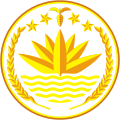| This article is part of a series on the |
| Politics of Bangladesh |
|---|
 |
|
|
|
|
Union councils of Jessore District (Bengali: যশোর জেলার ইউনিয়ন পরিষদসমূহ) are the smallest rural administrative and local government units in Jessore District of Bangladesh.[1] There are 8 upazilas in Jessore district with 00 Union councils. The list are below:
Abhaynagar Upazila
[edit]Abhaynagar Upazila has 8 unions, 000 mauzas, and 000 villages.[2]
- Prembag Union
- Sundoli Union
- Chalishia Union
- Payra Union
- Sreedhorpur Union
- Baghutia Union
- Shubharara Union
- Siddhipasha Union
Bagherpara Upazila
[edit]Bagherpara has 9 Unions/Wards, 156 Mauzas/Mahallas, and 191 villages. Unions Name
- Johorpur Union
- Bandobila Union
- Raipur Union
- Narikelbaria Union
- Dhalgram Union
- Dohakula Union
- Dorajhat Union
- Basuari Union
- Jamdia Union
Chaugachha Upazila
[edit]Chowgacha Union has 11 Unions/Wards, 149 Mauzas/Mahallas, and 166 villages.[3]
- Fulsara Union
- Pashapole Union
- Singhajhuli Union
- Dhuliani Union
- Chaugachha Union
- Jagadishpur Union
- Patibila Union
- Hakimpur Union
- Swarupdaha Union
- Narayanpur Union
- Sukhpukuria Union
Jhikargacha Upazila
[edit]Jhikargacha Upazila has 11 unions, 164 mouzas and 179 villages.[4]
- Ganganandapur Union
- Magura Union
- Shimulia Union
- Gadkhali Union
- Panisara Union
- Jhikargacha Union
- Nabharan Union
- Nirbaskhola Union
- Hajirbag Union
- Shankarpur Union
- Bankra Union
Keshabpur Upazila
[edit]Keshabpur Upazila has 9 union parishads, 142 mouzas and 143 villages.
- Trimohini Union
- Sagardari Union
- Majidpur Union
- Bidyanandakati Union
- Mongolkot Union
- Keshabpur Union
- Panjia Union
- Sufalakati Union
- Gaurighona Union
- Satbaria Union
- Hasanpur Union
Jessore Sadar Upazila
[edit]Jessore Sadar Upazila has 9 union parishads, 142 mouzas and 143 villages.[5]
- Hoibotpur Union
- Lebutala Union
- Ichali Union
- Arabpur Union
- Upashahar Union
- Kachua Union
- Kashimpur Union
- Curomonkati Union
- Chanchra Union
- Norendrapur Union
- Noapara Union
- Fatepur Union
- Bosundia Union
- Ramnagar Union
- Deara Union
Manirampur Upazila
[edit]- Bhojgati Union
- Chaluahati Union
- Dhakuria Union
- Durbadanga Union
- Haridaskati Union
- Hariharnagar Union
- Jhanpa Union
- Kashimnagar Union
- Khanpur Union
- Khedapara Union
- Kultia Union
- Manirampur Union
- Maswimnagar Union
- Monoharpur Union
- Nehalpur Union
- Rohita Union
- Shyamkur Union
Sharsha Upazila
[edit]- Bagachra Union
- Bahadurpur Union
- Benapole Union
- Dihi Union
- Goga Union
- Kayba Union
- Lakshmanpur Union
- Nizampur Union
- Putkhali Union
- Sharsha Union
- Ulshi Union
References
[edit]- ^ Khan, Mohammad Mohabbat. "Functioning of Local Government (Union Parishad): Legal and Practical Constraints" (PDF). Democracywatch. Archived from the original (PDF) on 17 April 2018. Retrieved 24 March 2012.
- ^ "Bangladesh Population and Housing Census 2011: Zila Report – Jessore" (PDF). Table P01: Household and Population by Sex and Residence, Table P05: Population by Religion, Age group, and Residence, Table P09: Literacy of Population 7 Years & Above by Religion, Sex, and Residence. Bangladesh Bureau of Statistics (BBS), Ministry of Planning, Government of the People’s Republic of Bangladesh. Retrieved 17 December 2018.
- ^ "Chaugachha Upazila". Banglapedia. Retrieved 21 July 2016.
- ^ "Population Census Wing, BBS". Archived from the original on 2005-03-27. Retrieved November 10, 2006.
- ^ "Bangladesh Population and Housing Census 2011: Zila Report – Jessore" (PDF). Table P01 : Household and Population by Sex and Residence, Table P05 : Population by Religion, Age group and Residence, Table P09 : Literacy of Population 7 Years & Above by Religion, Sex and Residence. Bangladesh Bureau of Statistics (BBS), Ministry of Planning, Government of the People’s Republic of Bangladesh. Retrieved 17 December 2018.



Well, that’s interesting to know that Psilotum nudum are known as whisk ferns. Psilotum nudum is the commoner species of the two. While the P. flaccidum is a rare species and is found in the tropical islands. Both the species are usually epiphytic in habit and grow upon tree ferns. These species may also be terrestrial and grow in humus or in the crevices of the rocks.
View the detailed Guide of Psilotum nudum: Detailed Study Of Psilotum Nudum (Whisk Fern), Classification, Anatomy, Reproduction